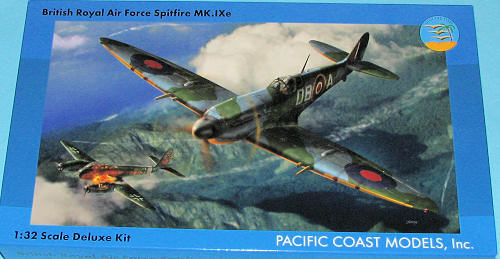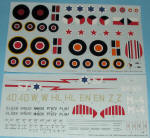
Pacific Coast Models 1/32 Spitfire IXe
| KIT #: | 32006 |
| PRICE: | $59.95 MSRP |
| DECALS: | Six options |
| REVIEWER: | Scott Van Aken |
| NOTES: | Short run kit with resin detail parts |

| HISTORY |
We all know that the Spitfire was one of those 'planes that saved the world for Democracy' so a detailed history is probably going to be redundant to most. What I will concentrate upon is this particular variant, the Spitfire IXe. The Spit IX was basically a case of adding the latest engine to older airframes until more of the 'true' upgraded variant, the Mk. VIII could be built in large numbers. Well, as things often turn out, vastly more of the Spit IXs were produced (and that included new build airframes), than the VIII. Initially it came with the somewhat standard C wing with cannon and .303 Brownings, but in early/mid 1944 the 'universal' or E wing arrived on scene. This one had no outer wing guns, the cannon slightly moved back and in a different position with .50 cal machine guns inboard.
For more detail on this, here is what Jeff Webb on http://www.spitfiresite.com/ had to say about it:
"A new wing was introduced in early 1944 - type E. Structurally unchanged from the C wing, the outer machine gun ports were eliminated. Although the outer machine gun bays were retained, their access doors were devoid of empty shell case ports and shell deflectors.
The inner gun bays allowed for two weapon fits two 20 mm Hispano Mk II cannon with 120 rounds/gun in the outer bays and two American .50 calibre M2 Browning machine guns, with 250 rounds per gun in the inner bays. Alternatively, four 20 mm Hispano cannon with 120 rounds per gun could be carried as per original C-wing production standard.
The cannon in the E wing was slightly relocated, positioned further to the rear in its bay. Consequently, the protruding portion of the barrel was shorter and almost entirely enclosed by a new cigar-shaped fairing. Also, the overwing blister was more narrow and a little deeper than the corresponding feature of the C wing.
An interesting curiosity is that several C-wing Spitfires LF Mk. IX of No. 485 (New Zealand) Squadron were converted to carry the Hispanos and .50 Brownings just before D-Day. "
| THE KIT |
Tom Cleaver did a nice preview of the Spitfire IXc that he received from Pacific Coast and you can read that here. The plastic and resin seem to me to be the same in this kit as in the Spit IX. The kit only comes with the larger elevators that have the extra 'kink' in it. I think this would be appropriate for later Spit IXs and by the time the IXe came about, they'd probably all have that as part of the standard build.
Now let me say up front that the kit is very nicely molded. It
is a short run kit and as such, you'll find ejector towers to remove, some tiny
a mount
of flash on a few pieces and some roughness of the parts that were not actually
detailed. By this, I mean that on the inside of the trailing edge of the wings,
for instance, there is no detail, but that area is rough compared to the outside
of the part and you'll need to sand it down smooth before gluing. I also found
that on one of the wing tips, there was some built up residue and a large
ejector tower. Again, though this was on the outside, cutting the tower remnant
and sanding will be enough to bring it back to specs. Now before you start
sending hate mail, this was the worst case with the vast majority of the rest of
the parts unaffected by molding glitches of any kind.
mount
of flash on a few pieces and some roughness of the parts that were not actually
detailed. By this, I mean that on the inside of the trailing edge of the wings,
for instance, there is no detail, but that area is rough compared to the outside
of the part and you'll need to sand it down smooth before gluing. I also found
that on one of the wing tips, there was some built up residue and a large
ejector tower. Again, though this was on the outside, cutting the tower remnant
and sanding will be enough to bring it back to specs. Now before you start
sending hate mail, this was the worst case with the vast majority of the rest of
the parts unaffected by molding glitches of any kind.
As Tom pointed out, the molding work on the resin is top notch. This is superbly molded and includes two styles of main wheels: one with five spokes and one with wheel covers. The resin attachment points are old school in that they are large and will require a saw or power sander to remove. Also very nicely done is the photo etch fret. It is not a complex one and having color for the instrument panel is a real boon for many of us.
One of the situations that sometimes arises when using one set of molds for several variants is that sometimes things are missed. It seems that the instructions in several cases have the construction drawings taken right from the IXc boxing. For instance, they show the canon barrels being installed inboard when an outboard installation is correct for the E. There is no .50 cal machine gun barrel opening for that gun so you'll have to improvise by sanding and drilling on the small recoil stub provided. While there are no holes for the .303 outer wing guns, the bottom of the wing still has the shell ejector chutes in place (though on my wing, many were filled with blobs of plastic). This will need to be filled and sanded down if the information in the history section is correct. You'll also have to add one for the cannon, as again, the kit basically provides a C wing.
The instructions also show that only the rounded rudder is to be used whereas all but one of the markings options uses the pointed one. I'd also check references regarding wing tips as some of these post war planes may well have had the clipped wing tips (another item shown as crossed off but included in the kit). I'm also not really sure which of the two exhaust would have been used as the instructions show either, while the markings profiles only show the 'flatter' ones. I know that the tubular exhaust were popular late war additions for the Packard powered Mk XVI and may have been for the later Rolls Royce IX as well. Again, check your reference photos to be sure. Now all of this will not be a problem for the Spitfire fanatic, but for those not familiar with the differences, it could cause some errors to creep in.
 The
kit comes with a pair of huge decal sheets, superbly printed by Cartograf. They
are so large as not to fit on the platen of my scanner. There are markings for
six aircraft, many of them post-war, and unless noted, in the standard RAF
camouflage of the day.
The
kit comes with a pair of huge decal sheets, superbly printed by Cartograf. They
are so large as not to fit on the platen of my scanner. There are markings for
six aircraft, many of them post-war, and unless noted, in the standard RAF
camouflage of the day.
First up is a 331 Squadron (Norwegian) aircraft from September 1945. This one has Norway's tricolor tail stripes and is the only one of the options with a rounded fin top. Next is a 40 Squadron, South African Air Force plane from no particular time. This one has Dark Earth in place of the Grey on the upper side and Azure Blue undersides.( Reader James Feuilherade writes: Just a point of interest on your review of the PCM 1/32 Spitfire IXe. The South African decals are for a SAAF Spitfire in Italy 1944, which actually was unusually painted in the earlier dark earth and green como scheme. The decals are marking for the aircraft flown by Bob Rogers, the CO of 40 Sqn SAAF at the time. He later became Chief of the South African Air Force in the late 70's.) In Czech markings is one from 1945 and the mount of WingCo J. Hlado. A 74 Squadron plane from March 1945 is the fourth option. Fifth is the all black with red lightning bolt, radiator housings, and spinner of Ezer Weizman, Israeli Air Force in late 1970. Finally, a Russian AF version from an unknown unit on an unknown date.
A full color placement guide is provided, but again, I caution the builder to verify the wing tips on the one he is building to be sure they are not clipped as some of these may be. Interestingly, the box art plane is not one of the options! Fortunately for many of us, there are starting to be produced, a number of aftermarket decal sheets that can be used on these planes.
| CONCLUSIONS |
If you are not gun-shy about spending $60 for a 1/32 Spitfire (and actually, that is a fair price in today's market), then this is the one for you. Just beware that you'll need to do a bit of additional research and that there are some glitches in the instructions. Should build into a real beauty.
| REFERENCES |
March 2009
Thanks to 'store credit' at CRM hobbies for this one.
If you would like your product reviewed fairly and fairly quickly, please contact the editor or see other details in the Note to Contributors.